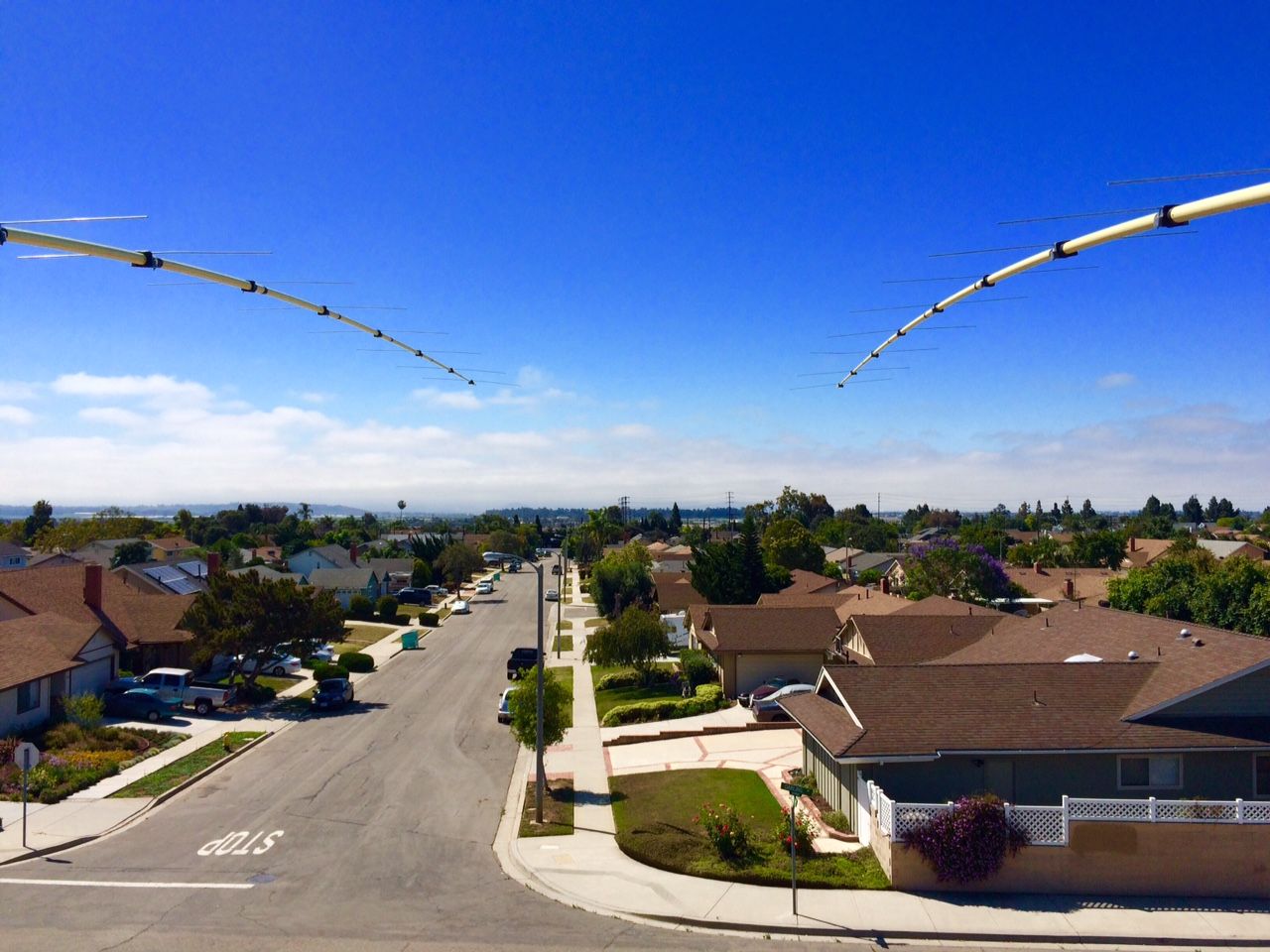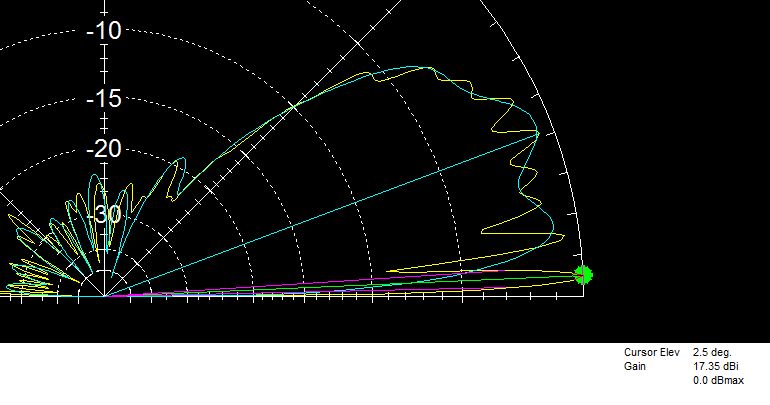SECTION 31
ADVANTAGES OF REAR MOUNTED CONFIGURATION AND LOW ANTENNA HEIGHT FOR EME WORK
(July 3rd, 2015)

One of our fundamental instinct as amateur radio enthousiast is to put up antennas as high as possible. This generally translates into better DX performance, clearer path, etc. But in the case of EME work, is this a good idea?
The picture to the right shows the 2X14 RPOL array on the roof at 35-foot above the ground overlooking the entire City. One can only imagine that the potential noise intake from such physical location can be extremely significant. The noise can reach the antenna from all directions, including the bottom where my own home is located.
As discussed in the previous sections, it has been observed that the noise level on the 2X14 array is generally 2-4 dB higher than what is observed with the 13-Element RPOL LFA antenna, which is located in the backyard at only 5-foot above the ground. In fact, my experience so far is that the RX performance of the 13-Element is absolutely formidable and outperforms the 2X14 array. Some of the reasons are given in the Section 29, but is there more to the story?
The unique "Rear Mounted" configuration of the RPOL system described on this website enables setting up the antenna at extremely low height above the ground (3-6 foot range). Is it possible that an antenna being located so close to the ground offers a unique and significant advantage for EME work? Let's see what EZNEC modeling is telling us...
For the purpose of this modeling exercise, we are assuming that the moon is at 20 degrees of elevation and that the antenna is aiming at the moon (so antenna elevation = 20 degrees). The EZNEC model compares the radiation patterns of the 13-element RPOL LFA when mounted at only 5-foot above ground versus 35-foot, which is close to the height of the 2X14 ARRAY.
The yellow curve in the radiation pattern plot represents the antenna at 35-foot above ground and the blue curve the one at only 5-foot. The results of the modeling exercise are extremely interesting. In the case of the antenna located at 35-foot above ground, although the antenna is aiming at the moon at an elevation angle of 20-degrees, one can see that there is still a massive residual Ground Gain lobe of 17.35 dBi peaking up at 2.5 degrees above the horizon! At the low angles above the horizon, that is <3 degrees where most of the City noise originates from, the antenna located at 35-foot above the ground (yellow curve) display significant forward gain figures which may translate into significant urban noise pickup. The picture of the 2X14 array overlooking the City puts this potential threat in real world perspective...

To the contrary, the antenna located at only 5-foot above ground (blue curve) paints a very different picture where at low angles above the horizon, the forward gain figures are much lower, resulting in a "quieter antenna" due to a better rejection of the City noise a these low angles.
The table below shows the forward gain figures of both antenna height configurations at different angles above the horizon. At the lowest angles above the horizon (<1.5 degree), the difference is in the order of 10 dB+ better noise rejection in favor of the antenna located at 5-foot above ground. That is extremely significant in the world of EME. I have modeled both antenna heights at other elevation angles (e.g. moon/antenna aiming at 45 degrees instead of 20 degrees) and the conclusions remain the same with slightly different forward gain figures.
So in addition to be physically less exposed to the urban noise being closer to the ground, the antenna at low height will provide a much better rejection of the noise at the critical low angles above the horizon.
These attributes are very significant, and may represent a massive performance advantage playing in favor of the 13-element RPOL LFA which is setup near ground level in the backyard. These attributes combined to all the other performance advantages described in Section 29 most likely explain the outstanding RX performance of this antenna system. It is important to note that none of that would be possible without the enabling "Rear Mounted" nature of this RPOL system, which may turn out to be a much more significant performance advantage than previously envisioned.
|
Angle above the Horizon
(degrees)
|
Antenna Forward Gain at 5-foot above Ground
(dBi)
|
Antenna Forward Gain at 35-foot above Ground
(dBi)
|
Forward Gain Difference 5-foot versus 35-foot
(dBi)
|
| 0.5 |
-4.1 |
7.4 |
-11.5 |
| 1.0 |
1.9 |
12.9 |
-11.0 |
| 1.5 |
5.3 |
15.7 |
-10.4 |
| 2.0 |
7.7 |
17.0 |
-9.3 |
| 2.5 |
9.5 |
17.4 |
-7.9 |
| 3.0 |
10.9 |
16.9 |
-6.0 |
 One of our fundamental instinct as amateur radio enthousiast is to put up antennas as high as possible. This generally translates into better DX performance, clearer path, etc. But in the case of EME work, is this a good idea?
One of our fundamental instinct as amateur radio enthousiast is to put up antennas as high as possible. This generally translates into better DX performance, clearer path, etc. But in the case of EME work, is this a good idea? One of our fundamental instinct as amateur radio enthousiast is to put up antennas as high as possible. This generally translates into better DX performance, clearer path, etc. But in the case of EME work, is this a good idea?
One of our fundamental instinct as amateur radio enthousiast is to put up antennas as high as possible. This generally translates into better DX performance, clearer path, etc. But in the case of EME work, is this a good idea? To the contrary, the antenna located at only 5-foot above ground (blue curve) paints a very different picture where at low angles above the horizon, the forward gain figures are much lower, resulting in a "quieter antenna" due to a better rejection of the City noise a these low angles.
To the contrary, the antenna located at only 5-foot above ground (blue curve) paints a very different picture where at low angles above the horizon, the forward gain figures are much lower, resulting in a "quieter antenna" due to a better rejection of the City noise a these low angles.